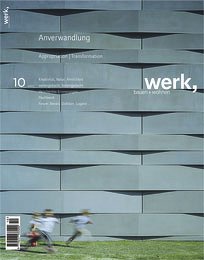Editorial
Editorial
Writing and drawing alike often begin with a white sheet of paper. In the empty space, lines and signs are created while work progresses. When and how are thoughts of the not yet constructed transformed to plans and scriptures? The beginnings are hard to identify as we ourselves are, literally, no blank pages. In spiritual teaching there exist people, in fact, who serve as media for transferring metaphysical ideas to the world of language. Under project planning, though, it is the rule that an effort, sometimes small, sometimes large, is necessary in order to arrive at a project.
The appropriation/transformation of tradition is the actual form of artistic invention, writes art historian Werner Busch in „Das sentimentalische Bild“ („The Sentimentalic Picture”, Munich, Beck 1993). Beyond dispute, adaptation is a form of invention: Absorbing a type or interlacing an analogy are newly found thoughts every time. They originate from tradition in the words widest sense, the pool of that known unto us. The appropriation/transformation is not a quotation or direct translation. Much more, it contains a shift and a treatment. Whoever appropriates a thought transforms it, hence lending it a new imprint. The spread of possible transfers into the own sphere of influence reaches from a subtly graded new interpretation, all the way to a productive misunderstanding. All of these are monopolizations, a renunciation of authenticity in favour of a synthesis of strong and memorable properties… the capacity of adaptors to integrate the adapted into the new context overshadows the pristine rendering of origins. How else could children enjoy playing Cowboys and Indians?
„Writers block“ is the expression used for the state of a writer who cannot write. But thoughts are not lacking, quite opposed: There is a block, a jam, like in rush-hour traffic, when too many users want to pass through a road. Thoughts first want to be organised and exploited before they are fitted into the project. The ”exploiting look” is also typical of architects, and will hopefully find much worth exploiting in this issue.
The white sheet never remains empty in the imagination, but condenses to a possible landscape of signs and drawings, similar to a palimpsest, which is repeatedly wiped off and used as an area for writing anew. In 1845, Thomas de Quincey described these scripts as a metaphor for memory: „What else than a natural and mighty palimpsest is the human brain? Such a palimpsest is my brain; such a palimpsest, O reader! is yours.“ (The editors)
